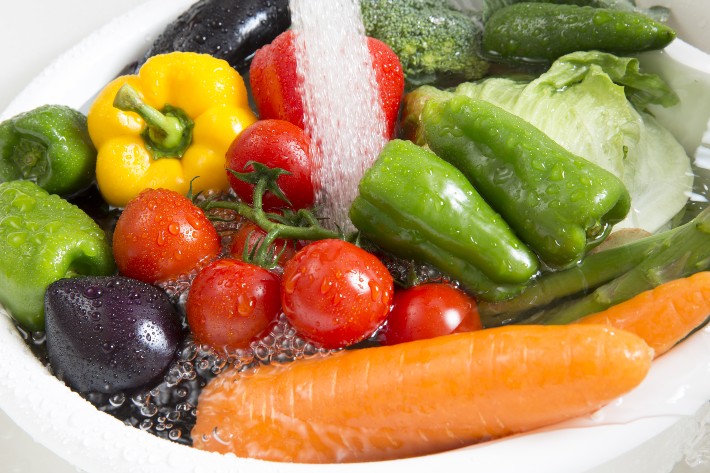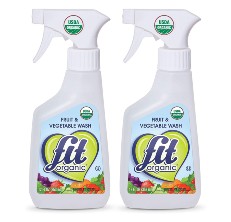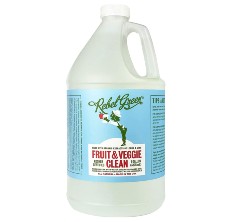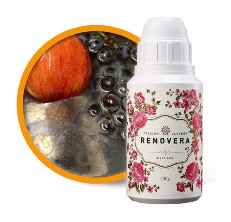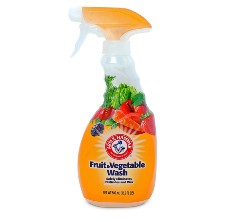- Flowers & PlantsVegetablesOur content is meticulously curated through independent research, testing, reviews, and AI-driven recommendations, all designed to present you with the finest product choices. When you make a purchase through our links, it could result in us earning a commission.
The Best Fruit and Veggie Wash of 2024
Last updated: Apr 27, 2024
Vegetables might be nutritious, but most are pretty dirty on the surface. Because many vegetables are root crops, which grow in soil, particles can build up on the surface of the vegetables over time, and the last thing you’d want is to digest them in your next meal. That’s where the best fruit and veggie washes of 2024 come in. Vegetable washes are a great alternative to just rinsing the vegetables in water. And lucky for you, we've tried and tested the best on the market. The ECOS® Non-Toxic Fruit + Veggie Wash is our top choice, but we've also included several great options as well!
Our Top Picks For Fruit and Veggie Washes
- Best Overall: ECOS® Non-Toxic Fruit + Veggie Wash Shop Now ➔
- Runner Up: Fit Organic Produce Wash Shop Now ➔
- Honorable Mention: Rebel Green Fruit & Veggie Wash Shop Now ➔
- Contender: Renovera Organic Fruit and Vegetable Cleaner Shop Now ➔
- Also Consider: CR Brands Fruit & Vegetable Wash Shop Now ➔
View all ContentsThe Best Fruit and Veggie Washes
Best Overall
The ECOS® veggie wash is great for not just vegetables but for fruits as well. The formula used in ECOS® is non-toxic, so you don’t have to worry about getting any diseases or sickness from using the wash. Even though it’s mentioned as a wash, it comes in a spray bottle and can be easily applied to various vegetables and fruits as you prepare them for your next meal. Its overall efficiency wins the title of best overall on our list.
Pros
- Ideal for soaking
- No odor
Cons
- Not always available on store
Runner Up
Many vegetables, fruits, and other forms of produce are coated in a layer of edible wax. This wax is meant to keep the produce looking fresh, minimize bruises, and keep them ideal for shipping. This is great for businesses, but not so much for the consumers. Fit Organic produce wash gets rid of any sort of wax that’s applied to the produce so you don’t have to worry about digesting it.
Pros
- Spray-bottle design for easy application
- Made out of food ingredients
Cons
- Not ideal for soaking
Honorable Mention
Rebel Green’s fruit and veggie wash is great if you want large amounts of vegetable wash available at a time. The previous products came in spray bottles, which were ideal for small batches of fruit and vegetables. However, they don’t last for very long, and you’ll be using quite a bit of it when soaking. You’ll need more vegetable wash if you, say, run a restaurant or cook for a large number of people.
Pros
- Great for soaking
- Sustainable production
Cons
- Spray bottle not included
Contender
The Renovera Organic fruit and veggie cleaner can be good or bad depending on how you prefer using vegetable cleaners. If you’re the type who soaked their fruits and vegetables, this is the product for you, since that’s its intended use. However, if you prefer spraying the wash instead of actually soaking the vegetables, you may want an alternative to this product instead.
Pros
- The powder-based formula makes it great for soaking
- Completely safe to use
Cons
- Can’t be used to clean vegetables in other ways
Also Consider
CR Brand fruit and vegetable wash is the wash for people who are worried about pesticides being part of their meal. The formula gets rid of at least 90% of pesticide residue if used in its directed manner. This is especially useful for vegetables that are commonly sprayed with pesticides to keep them pest-free, such as corn.
Pros
- Unscented formula
- Removes over 90% of pesticide residue
Cons
- More affordable alternatives are available elsewhere
Fruit and Veggie Wash: A Buying Guide
Fruit and veggie washes are one of the easiest ways to clean your vegetables and fruits without using vegetable brushes or soaking them in water. They are also made out of safe ingredients, usually other food ingredients, making them safe to wash with. Here’s what you need to know when buying vegetable wash.
The Importance of Fruit and Veggie Washes
Vegetable wash is a substance used on vegetables and fruit to clean them. The substance gets rid of any dirt or particles attached to the surface of the fruit or vegetable, as well as most pesticide residue and wax.
The Different Types of Fruit and Veggie Washes
Liquid-based
Liquid-based vegetable washes come in bottles – usually, spray bottles. These washes are commonly applied directly to the surface of the fruit or vegetable to clean them immediately. They can also be used as an agent for soaking your fruits and vegetables, which achieves the same result. However, this may be inefficient and a waste of wash for some, which is why liquid-based washes are often applied directly rather than as an ingredient for soaking.
Powder-based
While liquid-based washes are great for a quick cleaning, powder-based washes are best for soaking. The powder is mixed with water, resulting in a mixture that works like a liquid-based wash. For this reason, powder-based washes are often used to soak large amounts of fruits and vegetables at a time. You may even fill an empty spray bottle with the mixture instead if you prefer direct application.
Tips for Using Fruit and Veggie Wash
Spray bottles are your friend
Vegetable washes are packed in spray bottles for a reason. You only need one or two sprays per fruit or vegetable for the wash to work its magic. Let the wash settle for a bit before rinsing with water to really let the wash kick in and dismantle the dirt and pesticides on the surface.
Don’t put too much powder
When using powder, it’s important that you don’t mix too much or too little. Too much powder can make the mixture too concentrated, and too little powder will result in less-than-ideal rinsing. Be sure to follow the instructions as provided by the product manufacturer to ensure that you get the expected results.
Check the video for some useful tips to clean your fruits and vegetables!
How to Use Fruit and Veggie Washes
Some people may be wondering as to how often one should use a vegetable wash. Ideally, you’ll want to use it every meal, but some would consider that to be a waste of both time and money. As such, here are a few guidelines to help you consider when you should use the vegetable wash, and when you shouldn’t. As safe handling of produce can reduce the risk of contamination, it is always recommended to clean vegetables before consumption.
Firstly, let’s talk about fruits and vegetables. In general, fruits are cleaner than vegetables. This can be due to a variety of reasons, but one of the biggest reasons is that fruits hang safely above trees or stalks, whereas vegetables are closer to the ground, making them more prone to accumulating dust and dirt. Of course, there are exceptions to this, but you get the picture.
And even among vegetables, some are “cleaner” than others. For example, corn is a common vegetable that’s subject to all sorts of pesticides and insecticides to keep it safe from critters. This makes them more likely to contain residue from pesticides when you buy one on the market.
Finally, there’s the actual marketplace to consider. Some markets follow strict sanitary procedures to ensure that all products sold inside keep up with their standards. This results in generally cleaner fruits and vegetables. Other marketplaces, however, aren’t so strict. You can expect some of these fruits and vegetables to be a little dirtier than the ones you find at, say, a supermarket.
With all that being said, how do you figure out what to wash and what not to wash? It’s simple – create a hierarchy or order of food to wash, from highest to lowest priority. The highest priority on the list is root crop vegetables that are sold in less sanitary markets. The moment those veggies come out of the vegetable bags, they should definitely be washed. You can then work your way down the list, with fruits being less of a necessity to wash, etc. Of course, if you spot a bit of dirt on your fruit or vegetable, no matter where it came from, giving it a thorough washing wouldn’t hurt.
People Also Asked
Is vegetable wash safe?
Vegetable wash is made up of safe ingredients - usually other fruits and vegetables. These break down dirt and pesticides without introducing any new harmful chemicals.
What does vegetable wash smell like?
Virtually all vegetable wash products sold these days are odorless. This is to prevent the wash from introducing new flavors and scents when you cook or prepare the vegetable later on.
Is vegetable wash necessary?
Depending on what you want to wash away, yes. If you just want to get rid of dirt and particles, soaking and rinsing should do the job, and a vegetable brush can handle the stubborn specks. For wax and pesticide residue, however, you’ll need vegetable wash to get rid of them effectively.
Article Contributors
Read More About Garden Gate Review Team HereThe Garden Gate Review Team is a group of writers, editors, and gardeners, dedicated towards writing trustworthy product reviews that'll help you choose the best products for a beautiful garden and backyard.
Garden Gate is reader-supported: When you buy through links on our site, we may earn an affiliate commission. Artificial Intelligence (large language models) may have been used in the research and creation of the content.
Please reach out to aimperiapt@gmail.com with any questions regarding product testing or specific articles.
